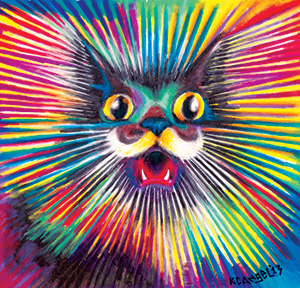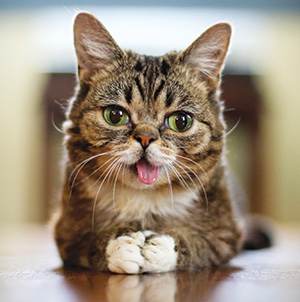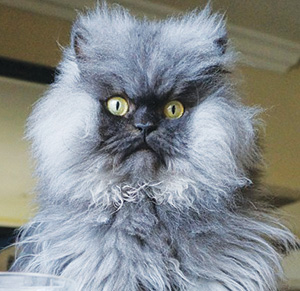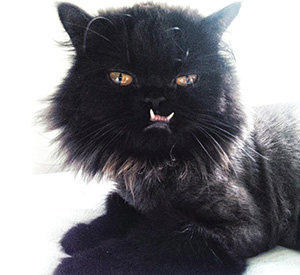Features & Columns
Viral Cats Create a New Industry
 Illustration by KC Angel | kcangel.com
Illustration by KC Angel | kcangel.com
Freakin' hipsters. I've only just met him, but already Hamilton is so over me.
When I walk in, he's sitting near his "study"—an armchair, desk, globe and house plant. I reach out to pet him, but he arches back and hisses before darting behind the fake ficus tree. Only after I ignore him for a beat and retreat to the couch does he spring up to his mini navy-and-white polka dot armchair and drape a paw over the armrest. He glances at me, the intruder, with his patented more-dapper-than-thou gaze. Fine.
Hamilton the Hipster Cat lives with his owner, Jay Stowe, whose single-bedroom flat looks like a run-of-the-mill bachelor pad, save for a miniature living room set-up for his cat, boxes of kitty-emblazoned T-shirts and a proliferation of pet toys.
"No, I'm not a crazy cat lady," he jokes.
Granted, it's because of a cat that his life took a turn for the crazy. Stowe's a friend, but it's this feline ward I'm here to see: Hamilton, a long-haired gray-and-white Maine Coon mix with a Salvador DaliĞesque mustachelike marking that's made him famous.
 Hamilton the Hipster Cat: Perhaps the only member of the Pack known for a dashing appearance, Hamilton nonetheless isn't all about his looks, though presumably that's what has drawn 356,000 Instagram followers and just under 50,000 Facebook likes. He's still down-to-earth and would rather carry around his lucky penny or go berserk over a feather toy than pose for pictures. Like most of his comrades, Hamilton's an advocate for shelter adoptions since that's where he came from. He may look quite the gentleman now, but Hamilton was raised as a foster kid, scooped up by the Humane Society from a hardscrabble life as a South Bay street cat.
Hamilton the Hipster Cat: Perhaps the only member of the Pack known for a dashing appearance, Hamilton nonetheless isn't all about his looks, though presumably that's what has drawn 356,000 Instagram followers and just under 50,000 Facebook likes. He's still down-to-earth and would rather carry around his lucky penny or go berserk over a feather toy than pose for pictures. Like most of his comrades, Hamilton's an advocate for shelter adoptions since that's where he came from. He may look quite the gentleman now, but Hamilton was raised as a foster kid, scooped up by the Humane Society from a hardscrabble life as a South Bay street cat.
Cult of Cat
Hamilton is part of a sociological phenomenon distinct to the digital age: the celebrity cat. The curiously marked mouser adopted from the Humane Society Silicon Valley in mid-2012 catapulted to fame after his owner started posting pictures of his handsome mug on Instagram. The response was electric. In the span of a year, he's collected more than 350,000 followers on the photo-sharing platform, plus thousands more on other social media channels. People send in fan art—skillfully crafted oil paintings, sketches and digital illustrations.
Things took off for Hamilton this summer when SFgate.com ran a blog I wrote about his uncanny facial fur. Then Buzzfeed picked it up, followed by major newspapers around the world. Interview requests began flooding in. In the past several months, he's been featured on Ellen, Good Morning America, The Today Show, ABC7 Bay Area and in a slew of other TV shows and publications. His owner is in touch with a publisher about a book deal. He landed a T-shirt deal with Urban Outfitters and Hot Topic. He's starred in Friskies' ads, was spokescat for Scope during last year's facial-hair-growing and men's health-promoting "Movember" campaign and landed his own Discovery Channel-backed web series aptly dubbed Before It Was Cool. The show is slated to debut later this month.
"It's been a whirlwind," says Stowe, a 31-year-old Campbell resident and standup comedian. He's determined to have people know that he's not a stage mom. "I didn't go out looking for this."
Hamilton's viral fame places him firmly in the upper echelon of the celebucat industry, part of the "Cat Pack," whose members peddle product lines and employ professional agents. Grumpy Cat (real name: Tardar Sauce) with her perpetual grimace, drew long lines of adoring fans at the South by Southwest music festival in Austin this year, while clothing at major retail chains bears her likeness.
The estimated value of the Grumpy Cat empire is somewhere in the million-dollar range. Lil' Bub, whose half-formed jaw forces her tongue to stick out, landed an Animal Planet TV show, Lil' Bub's Space Time Slumber Party, and released Lil' Bub's Lil' Book: The Extraordinary Life of the Most Amazing Cat on the Planet. The first episode of her web series, Lil' Bub's Big Show, included a guest appearance from Whoopi Goldberg. When Guinness world-record holder for the longest-furred cat on the planet, Colonel Meow, fell sick last month with heart complications, his fans raised $15,000 for vet bills in the first six hours after the announcement.
Perhaps more than any other time in the weird-wild course of humankind, people are psychologically invested in other people's pets. And with their engaged, often obsessed, online communities, these cats have become a vehicle for communication. We have Facebooks, Tumblrs, Twitters and Instagrams; feline faces adorn shirts, totes, iPhone cases, coffee mugs and cake pops. At the American Music Awards last week, Miley Cyrus belted out her whiny, woeful ballad "Wrecking Ball" in front of an enormous lip-synching virtual kitten. It was weird and unforgettable—the first thing anyone mentioned about the awards show. It was so 2013, the year of the Internet cat.
"Cats have permeated pop culture," says Mike Bridavsky, Lil' Bub's soft-spoken, tatted-up owner, a musician from Bloomington, Ind., who makes a serviceable salary as a full-time cat manager.
Now, with Hamilton the Hipster Cat, the South Bay has its own stake in the international cult of cat. Advertisers have taken note. Samsung sent Stowe—well, Hamilton, really—a Galaxy Note and smartwatch. Unsolicited, Fresh Step shipped over a 25-pound box of kitty litter imprinted with a picture of Hamilton scooping litter. Stowe's apartment has become a tiny, cluttered warehouse of cat merch to ship out, while freebies come in from corporate sponsors. "I know, it's weird," says Stowe, whose one-bedroom apartment is cluttered with boxes of Hamilton T-shirts, cat toys and a tiny armchair for his much-publicized ward. "This is my life now."
 Lil' Bub: If it weren't for her owner Matt Bridavsky's affinity for special-needs pets, Lil' Bub may never have found a home. This Indiana-based feline, the runt of the litter, was born with bone deformities that force her to get around by army crawl and a half-formed jaw that leaves her tongue continuously lolling out. Her bug-eyed gaze gives her the appearance of seeing everything for the first time, like she's perpetually in awe of the world. Bridavsky says he suspects she's actually an alien life form, sent to earth to inspire awe in others—including 521,000 Facebook followers, nearly 280,000 Instagram followers and more than 69,000 YouTube subscribers.
Lil' Bub: If it weren't for her owner Matt Bridavsky's affinity for special-needs pets, Lil' Bub may never have found a home. This Indiana-based feline, the runt of the litter, was born with bone deformities that force her to get around by army crawl and a half-formed jaw that leaves her tongue continuously lolling out. Her bug-eyed gaze gives her the appearance of seeing everything for the first time, like she's perpetually in awe of the world. Bridavsky says he suspects she's actually an alien life form, sent to earth to inspire awe in others—including 521,000 Facebook followers, nearly 280,000 Instagram followers and more than 69,000 YouTube subscribers.
A Virtual Cat Park
Since the advent of online photo- and video-sharing, cats have become an indelible fixture on the Internet. Cats populated cyberspace earlier than dogs, via 4chan and later Cheezburger.com. Though YouTube gets more searches for dogs, cat content is much more likely to go viral, says BuzzFeed's "Beastmaster" Jack Shepherd, a self-professed cat person.
Maru, a cat obsessed with empty boxes, clocked upward of 406,000 subscribers to her YouTube channel. Mishka, a Siberian husky who bleats "I love you" and "hamburger," among other random announcements, has the most popular pet YouTube channel with more than 516,000 subscribers but fewer video views. So dogs actually perform better in terms of quantity online—they're just not blowing up as much as individual cat content. Shepherd chalks it up to a personality thing. Dogs grovel, and that's just not cool.
"My personal theory about why cats have more 'viral potential' than their canine compatriots is that cats are better at making viral videos because dogs are trying too hard," Shepherd writes on BuzzFeed. "Dogs are the equivalent of a 'Viral Marketing Strategist' at an ad agency—sure, they'll have a hit now and again, but unless it's really exceptional work, you'll just ignore it, because you know they're doing it to get your attention."
When a dog jumps into a box, he's trying to impress you. A cat does it just because he wants to.
"Because they're so cool, calm and collected, we like to see them mess up," says Ryan Vance, head of development for Discovery Digital Networks, which produces Hamilton's web series on Animalist. He has another theory about why cats go viral.
"You'll find the major underpinnings of the Internet are tubes and cat videos," he jokes. "Dog owners, they have all these public spaces, they have dog parks. Dog people can find other dog people walking down the street. But if you're a cat person, you didn't really have that." Cyberspace filled that void. It became a virtual cat park.
Jonah Berger, a marketing professor at Wharton University of Pennsylvania and author of Contagious: Why Things Catch On, says cat media strike a chord in our collective consciousness that inspires heightened emotional interest, prompting people to share and reshare as it goes viral.
"The more emotionally connected we feel about something, whether it's humor or awe, the more we want to pass that on to someone else who can experience that, too," he says.
That adoration expressed so feverishly online is starting to spill over to real life, too, spawning the Internet Cat Video Festival in major cities across the United States. In Minneapolis, the festival drew about 15,000 people. Hamilton was invited, but declined the offer since fear of flying is one of his myriad phobias.
"There's also something about cats that's especially appealing," adds Vance. "You can so easily pull them out of context. They're so proud, they appear to be so intelligent and aloof and it's hilarious to us if we can knock a cat down a few pegs, to take a jab at their superiority over us."
Feline physiognomies remind us of our own, too, so it's easy to project our emotions onto the poor things, says Ben Huh, the man behind LOLcats, Fail Blog and the Cheezburger Network.
"Cats are more complex and expressive than dogs, which is why they are the rulers of the Internet," he says. "When people see cats doing humanlike things, they get excited because, for the most part, you can't teach a cat to do a trick. And that will always give them more of an allure over other common pets."
Stowe took a tone of anthropomorphic conceit when he started posting pictures of Hamilton on Instagram. Hamilton the Hipster Cat would pose with a can of PBR, a pack of American Spirits or a slice of pizza, which he ate "before it was cool." But over time, Hamilton's attitude lightened up. Stowe started posting a picture a day, responding to fans to express appreciation for all the support. Like the rest of the Cat Pack, who are all rescues, he started promoting shelter adoptions.
"Pretty quickly, it turned from a joke to realizing that I sort of had a responsibility to promote a positive message," Stowe says.
 Colonel Meow: The Colonel's furious expression and trumped-up reputation as a ruthless military commander belie a sweet temperament. He's really a bundle of purrs with a dour face who reserves all hatred for his owner's "stupid golden retriever" Boots. As the longest-furred kitty on the planet (Guinness Book of World Records' designation, not our estimation), he's got a grizzly, meme-worthy appearance that's garnered 12,000 YouTube subscribers and more than 245,000 Facebook followers. On his Facebook page, his owner notes that as the furriest feline, the Colonel possesses "the unfortunate ability to shit in his fur."
Colonel Meow: The Colonel's furious expression and trumped-up reputation as a ruthless military commander belie a sweet temperament. He's really a bundle of purrs with a dour face who reserves all hatred for his owner's "stupid golden retriever" Boots. As the longest-furred kitty on the planet (Guinness Book of World Records' designation, not our estimation), he's got a grizzly, meme-worthy appearance that's garnered 12,000 YouTube subscribers and more than 245,000 Facebook followers. On his Facebook page, his owner notes that as the furriest feline, the Colonel possesses "the unfortunate ability to shit in his fur."
Hard to Adopt
At the Humane Society Silicon Valley, no one wanted Hamilton. Too skittish. The baseball-sized bundle of fur was found in San Jose by a shelter worker, taken off the street and placed in a warm kennel. Stowe, kitten-shopping after a breakup, encountered young Hamilton a year and a half ago at the Milpitas shelter. All the other cats were dancing around, playfully batting their paws at visitors, practically begging to be adopted. Whenever someone went to grab Hamilton, he'd tuck his head into his belly.
"I was afraid that no one else would end up taking him," Stowe says. "There was a ton of people looking at kittens, and no one could get near him."
Maybe his aversion to eye contact prevented anyone from noticing his debonair mustache.
"I was the only one he would let pick him up," Stowe says. "He just had a hard kittenhood and needed to be in a loving, trusting environment."
When Stowe picked him up, Hamilton curled up into his neck, started purring and fell asleep.
No one else since has been able to earn Hamilton's trust like that. When ABC sent cameras to Stowe's place a few months ago, the cat retreated to the bathroom, hiding behind the toilet. For the first couple months after Hamilton moved in, he lived in that bathroom, refusing to venture into the open if anyone was around.
"At first, I wasn't sure if he could even walk," Stowe says.
But he saw proof in the litter box. And the empty cat food bowl. One day, at 3 in the morning, Hamilton started crying and popped up in the bedroom momentarily before retreating to the closet. He lived there for another month.
"It was impossible to predict that this little guy would go on to become a scion of Internet cat fame," says Lori Calvery, director of marketing for the Silicon Valley Humane Society, which sells Hamilton tees and tank tops at its gift shop.
Like a lot of famous cats, Hamilton was a reject. Lil' Bub was handed off to Bridavsky because she was too much to handle with her bone deformities, dwarfism and other ailments. Princess Monster Truck, a midnight-black longhair with a vicious underbite, roamed the streets of Brooklyn before stumbling into the artist couple that adopted her. Grumpy Cat's curmudgeonly look owes itself to feline dwarfism, which scrunches up her flat face and gives her that off-putting and oft-meme-ified perma-frown.
"There's something about these cats being freaks of nature that appeals to our sense of nurturing," says Tracy Timmons, Princess Monster Truck's human.
That's clearly true for Bridavsky. Lil' Bub requires extensive veterinary attention. Some of the proceeds from the cat's online store and other projects pay her medical bills. Her bug-eyed visage and lolling-out tongue, the result of medical ailments, make her look cartoonish and adorable. To Bridavsky, and thousands of others—she has more than 520,000 Facebook followers—she's one of the cutest cats in the world.
"The cats that seem to reach celebrity status are ones that don't try to be anything they are not," Huh says. "People tend to like Grumpy Cat, Lil' Bub and Hamilton because these cats are just being who they are, and they have a fun story."
People identify with a cat that's gone through a challenge or struggles with a disability.
"It makes us connect with them more because we know where they have come from and how they have become who they are," he says.
That's why Bridavsky believes Lil' Bub is so popular. People follow her struggle, they know her story, even if part of it—the she-came-from-outer-space part—is made up.
Like Bridavsky and Timmons, Stowe has turned Hamilton into a meowthpiece (sorry, can't help it) for pet adoptions. Every week, Hamilton features a new shelter on his Facebook page and re-shares pictures of cats up for adoption.
"They don't all have to be other mustache cats," Stowe says. "We just want to get the message out there that the best way to adopt a cat is from a shelter."
 Princess Monster Truck: With a fierce underbite, wild eyes and fluffy fur that stands on end as if she'd been electrocuted, you'd think Princess has a face only a mother could love. Actually, though, plenty of people find her monstrous appearance adorable (50,800 Instagram followers can't be wrong). Though not officially part of the Animalist's "Cat Pack," Princess remains a top contender for admission to the pack, which would mean her own web series, as opposed to guest starring on other felines' shows. Her artist parents rescued her scraggly self from the mean streets of Brooklyn—she crossed paths with the Timmonses late one night and locked eyes with her newly adopted humans. Her smashed-looking face and jutting-out jaw was too much to resist, so the Timmons took her home, posted some pictures and, eventually, turned their newfound street princess into a star.
Princess Monster Truck: With a fierce underbite, wild eyes and fluffy fur that stands on end as if she'd been electrocuted, you'd think Princess has a face only a mother could love. Actually, though, plenty of people find her monstrous appearance adorable (50,800 Instagram followers can't be wrong). Though not officially part of the Animalist's "Cat Pack," Princess remains a top contender for admission to the pack, which would mean her own web series, as opposed to guest starring on other felines' shows. Her artist parents rescued her scraggly self from the mean streets of Brooklyn—she crossed paths with the Timmonses late one night and locked eyes with her newly adopted humans. Her smashed-looking face and jutting-out jaw was too much to resist, so the Timmons took her home, posted some pictures and, eventually, turned their newfound street princess into a star.
Latter-Day Superstars
Historically—as in five years ago—we got enough of a kick out of cat videos, shared them with a friend or few and moved on with our sad little lives. Now, we follow celebrity felines like Hollywood stars, liking their status updates, resharing their photos, repurposing memes and reading about their health scares on Gawker or the New York Post.
Vance believes this type of stardom is here to stay, which forces us to re-examine the nature of fame. If pop culture is about vicarious living, about projecting our dreams and desires on some distant, deified personality, what does it mean when the celebrity is an animal?
"People are lonely, and they need a warm, safe place to connect," says Howard Sapper, a celebrity animal agent. "So they sit behind their computer screens, scrolling through pictures of cats and kittens because it makes them feel warm and fuzzy."
The difference, he says, is that animals used to be revered for a skill. Sapper represents the Olate Dogs, a circus-trained troupe that performs regularly at NBA halftime shows and won $1 million last year on America's Got Talent.
"It's kind of sad with this cat thing," he says. "You could say entertainment, animal celebrity has been reduced to the lowest common denominator." Hamilton, like every other feline A-lister, remains oblivious of his newfound fame. It's hard to compare the cult of cat to the traditional pet talent industry. Two different animals.
"A lot of this is about giving the audience what they want," Stowe says. "When the interest dies down, I'll go back to business as usual."


